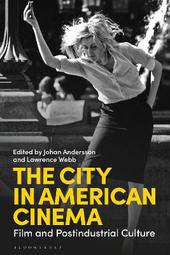
|
The City in American Cinema: Film and Postindustrial Culture
Hardback
Main Details
| Title |
The City in American Cinema: Film and Postindustrial Culture
|
| Authors and Contributors |
Edited by Dr Johan Andersson
|
|
Edited by Lawrence Webb
|
| Physical Properties |
| Format:Hardback | | Pages:400 | | Dimensions(mm): Height 234,Width 156 |
|
| Category/Genre | Landscape art and architecture
Film theory and criticism
Human geography |
|---|
| ISBN/Barcode |
9781788313186
|
| Classifications | Dewey:791.430973 |
|---|
| Audience | | Tertiary Education (US: College) | |
|---|
| Illustrations |
28 bw illus
|
|
Publishing Details |
| Publisher |
Bloomsbury Publishing PLC
|
| Imprint |
Bloomsbury Academic
|
| Publication Date |
27 June 2019 |
| Publication Country |
United Kingdom
|
Description
How has American cinema engaged with the rapid transformation of cities and urban culture since the 1960s? And what role have films and film industries played in shaping and mediating the "postindustrial" city? This collection argues that cinema and cities have become increasingly intertwined in the era of neoliberalism, urban branding, and accelerated gentrification. Examining a wide range of films from Hollywood blockbusters to indie cinema, it considers the complex, evolving relationship between moving image cultures and the spaces, policies, and politics of US cities from New York, Los Angeles, and Boston to Detroit, Oakland, and Baltimore. The contributors address questions of narrative, genre, and style alongside the urban contexts of production, exhibition, and reception, discussing films including The Friends of Eddie Coyle (1973), Cruising (1980), Desperately Seeking Susan (1985), King of New York (1990), Inception (2010), Frances Ha (2012), Fruitvale Station (2013), Only Lovers Left Alive (2013), and Doctor Strange (2016).
Author Biography
Johan Andersson is Senior Lecturer in Urban Geography at King's College London, UK. He is the co-editor, with Lawrence Webb, of Global Cinematic Cities: New Landscapes of Film and Media (2016), the co-author, with Gallent and Marco Bianconi, of Planning on the Edge (2006) and has published articles in journals such as Antipode, IJURR, Society and Space and Urban Studies. Lawrence Webb is Senior Lecturer in Film Studies at the University of Sussex, UK. He is author of The Cinema of Urban Crisis: Seventies Film and the Reinvention of the City (2014). He is co-editor, with Johan Andersson, of Global Cinematic Cities: New Landscapes of Film and Media (2016), and with Joshua Gleich, Hollywood On Location: An Industry History (2018).
ReviewsThe authors accomplish an immense feat when giving form to the feeling of incongruence that grips one as they walk through the locations these essays discuss ... [this book] gives one the language to understand one's place in the socio-spatial world. * Film Matters * The forging of cinema within the crucible of urban modernity has been well established by scholars, but what happens to this connection as both cities and filmmaking transform in the post-industrial era? This collection brings long overdue focus to the decades following World War II, demonstrating how the deep interrelation between cinema and the city is sustained in the way movies are made, where they're shown, and the we see on screen. -- Nathan Holmes, Visiting Assistant Professor of Cinema Studies, Purchase College, SUNY This collection offers an expansive bird's-eye view as well as street-level scrutiny of the post-classical cinematic cityscape, providing compelling, clear-sighted assessment of the mutually regenerative exchange between American cities and the U.S. film industry since the 1960s. Drawing on cultural geography, spatiality theory, and production and exhibition histories, (T)hese cogent, accessible essays map cinema's urban imaginaries and the cities and conditions out of which they are conjured, ranging from the postindustrial urban decline of American New Wave cinema to the gentrified "creative city" of recent indie film, from the outer borough to the indieplex, and from Nixon to Trump. -- Maria San Filippo, Assistant Professor of Communication & Media Studies, Goucher College, USA This vital collection provides a broad interrogation of how American film, through its representational and industrial practices, has been deeply involved in the re-making of urban space. -- Michael D. Dwyer, Associate Professor of Media and Communication, Arcadia University, USA As expected, New York and Los Angeles play a key role in investigating the postindustrial American city; the perceptive analyses of the spatial imagination and real spaces of postindustrial San Francisco, Boston, Oakland, and Detroit expand the book's scope and its importance to urban film studies. -- Christian Long, Honorary Research Fellow, School of Communication and Arts, University of Queensland, Australia A welcome addition to the literature on film and urbanism. Attends to the way different cities and genres imagine the urban and negotiate the unequal realities of postindustrial America. -- Pamela Robertson Wojcik, Professor of Film, Television, and Theatre, University of Notre Dame, USA Smartly conceived and elegantly organized, this collection illuminates the many ways that the rise of the post-industrial city has left its transformative mark on the past half century of American cinema. -- Derek Nystrom, Associate Professor of English, McGill University, Canada
|